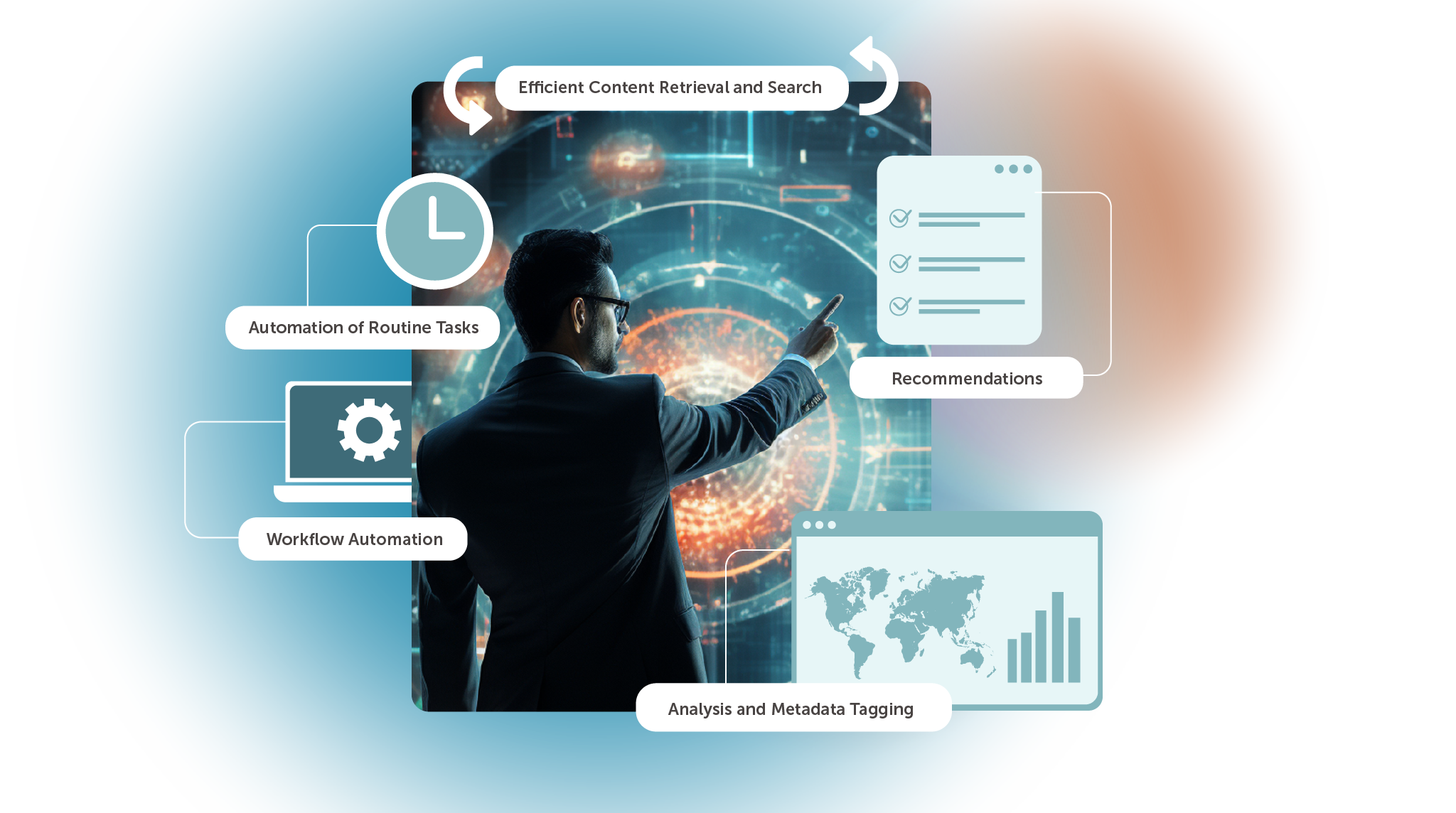The AI Revolution in DAM: Transformative Impacts on Digital Asset Management

Organizations today rely on a wide range of digital assets in their daily operations, from photos and videos to content and graphic designs. However, it is not enough to simply create and store assets if you cannot find and leverage them on demand, whether for increasing revenue, optimizing content, or personalizing customer experiences. Effectively storing, organizing, and retrieving these assets is known as Digital Asset Management (DAM).
Fortunately, artificial intelligence (AI) has emerged with AI DAM solutions to help organizations harness their digital assets’ full potential. Companies with strong AI digital asset management spend 28% less time searching for their digital assets every week. This AI transformation is crucial not just for efficient operations, but also for cost and resource savings.
TL;DR: Scaling Content Operations with AI
The integration of Artificial Intelligence (AI) has fundamentally redefined Digital Asset Management (DAM). AI automates repetitive tasks such as metadata tagging, content creation, workflow management, fraud detection, and predictive analysis. This intelligence significantly improves the speed and reliability of DAM. AI-powered systems can automatically categorize assets and enhance the accuracy of metadata tags based on user interaction, thereby minimizing manual labor and saving operational costs and resources. Furthermore, AI helps organizations maintain compliance with data protection regulations and enhance search capabilities through tools like Natural Language Processing (NLP).
The Evolution of DAM through AI and Machine Learning
Artificial intelligence simulates human intelligence, allowing computer programs to perform tasks that typically require cognitive functions such as learning, reasoning, and problem-solving. Digital asset management systems organize, store, and retrieve digital assets like photos, videos, and other multimedia content.
When DAM platforms integrate AI, they transform how businesses manage their digital assets. AI introduces intelligent features and automations that streamline asset categorization, tagging, and searching. This convergence speeds up workflows and enhances efficiency, productivity, and the user experience (UX).
In the early days of DAM, systems captured basic metadata, such as the file name and date. To find a specific file, a user had to input its basic information. With Machine Learning (ML) and AI technologies, businesses can now easily categorize and manage their digital assets. This evolution allows for much more complex search functionality; for instance, you can now find a photo by describing its content to the DAM system.

Transforming Metadata and Organization
One key advantage of AI DAM is automatic and accurate content analysis and metadata tagging. Many businesses struggle with manually tagging and categorizing digital files with correct metadata, but AI helps by generating descriptive metadata tags after analyzing a diverse range of content.
- Automated Tagging: Using advanced technologies like computer vision and machine learning, AI algorithms analyze digital media and categorize assets. For instance, AI can examine an image and recognize faces, landscapes, or objects, categorizing the asset based on its content without manual input. Generative AI can also be used for metadata creation and automated tagging.
- Intelligent Features: AI analyzes content to generate descriptive tags, which significantly improves the system’s search capabilities. ML algorithms enhance the accuracy of metadata tags based on user interaction. This reduces manual tagging and sorting, saving time and resources for more strategic activities.
- Optical Content Recognition (OCR): OCR is an effective use case of AI in DAM. It transforms image text into searchable text by identifying common points like objects, keywords, locations, and people. AI can even scan documents and translate their text to make them easily searchable and manageable.

Streamlining Workflows and Content Distribution
One of the greatest benefits of AI DAM systems is the ability to streamline workflows and enhance collaboration across the organization. AI learns from predetermined situations and rules to automate repetitive tasks.
Workflow Optimization
AI effectively streamlines DAM workflows and ensures that digital assets move seamlessly from creation to distribution. AI enhances this process by enabling smart workflows where tasks such as approvals, conversions, and publishing are triggered automatically based on predefined criteria. Enterprise DAM solutions often feature intelligent automation to manage complex content demands.
Examples of automated tasks include:
- Asset requests and approvals.
- Metadata extraction and audio transcription.
- Automating asset resizing, such as smart cropping to optimize images for platform-specific qualifications.
- Automating image editing and color correction adjustment.
Content Distribution and Creation
AI automates content distribution by analyzing the target audience, optimizing the timing for release, and selecting the best platforms for distribution without manual intervention. For instance, AI can learn the peak engagement times on social media and schedule posts accordingly, maximizing visibility and interaction rates. Global news agencies now use AI to distribute content across various platforms instantly for timely media delivery.
AI also lends a helping hand in content creation:
- Content Recommendations: AI-powered tools track and analyze user metrics (preferences, interactions, search history) to suggest relevant digital assets. This helps businesses offer personalized user experiences.
- Idea Generation: Creative teams can use AI content coaching to discover new ideas quickly. AI tools can provide inspiration and ideas for new content pieces and visual assets, and even generate written content outlines and social media posts.
Enhancing Search and Retrieval Through AI
AI in DAM makes asset search and retrieval easier, leading to better searches and content retrieval.
- Intelligent Search: AI leverages Natural Language Processing (NLP) to provide users with quick search features and sophisticated search capabilities. Users do not have to remember precise keywords; instead, the DAM system identifies and interprets the query to deliver the most relevant results.
- Search Capabilities: Real-world enhancements include visual search, where users can find similar images by searching with an image instead of text.
- Personalized Results and Predictive Tagging: AI and ML algorithms analyze user search patterns to predict the assets they may look for in the future, known as predictive analysis. This process suggests relevant tags and recommends pertinent content, increasing user satisfaction and content utilization. Predictive tagging enables the DAM platform to scale up as assets grow without compromising accuracy or speed.
Security, Compliance, and Industry Use Cases
The AI revolution is also driving improvements in security, compliance, and asset usability across various sectors.
AI-Powered Security and Compliance
Organizations must train their AI models on security regulations to detect fraud and policy violations within the DAM platform.
- Security Measures: AI and ML algorithms analyze the patterns of malicious activities and highlight harmful interventions in real time. AI-powered content recognition tools identify sensitive data within digital assets to ensure content managers use safe access methods.
- Compliance Adherence: AI helps organizations maintain compliance with data protection regulations by comparing existing data handling practices with regulatory requirements, identifying loopholes, and suggesting improvements. AI features like face recognition in digital media can also be leveraged for security, filtering, and personalization. Furthermore, AI DAM acts as a gatekeeper to support effective copyright management.
Industry Use Cases
AI DAM technologies provide transformative benefits across many industries:
- Media and Entertainment: AI’s content recognition facilitates advanced archiving and assists in managing copyright materials.
- E-commerce: Incorporating AI enables better personalization throughout the customer journey, resulting in greater conversion rates and increased revenue. Consumers can search for products through visual cues, streamlining the shopping experience.
- Healthcare: AI can tag and categorize medical images, allowing for quicker retrieval, reduced errors, and potentially more accurate diagnoses.
- Financial and Legal Services: AI tools can analyze, categorize, and retrieve financial documents and automatically sort legal documents with precise topical tags, improving processing times and ensuring compliance.

Bottom Line
The AI revolution in DAM transforms intelligent asset management from simple storage into a strategic tool that automates processes, enhances security, and maximizes content discoverability. By leveraging features like generative AI for metadata creation, predictive tagging, and streamlined workflows, an AI-powered DAM system unlocks full content potential. This intelligence helps organizations save time wasted searching for assets, recreating lost ones, and seeking asset approval from stakeholders. As AI technology evolves, its addition to DAM platforms will continue to make digital asset management more sophisticated. When selecting a platform, look for one that fits your operational requirements today, and has the scalability to grow with you tomorrow.
Frequently Asked Questions
What is AI Digital Asset Management (AI DAM)?
AI Digital Asset Management occurs when DAM platforms integrate artificial intelligence to transform how businesses manage their digital assets. AI introduces intelligent features and automations that streamline asset categorization, tagging, and searching. AI simulates human intelligence, allowing computer programs to perform cognitive functions such as learning and reasoning.
How does AI revolutionize metadata tagging?
AI revolutionizes metadata tagging by using advanced technologies like computer vision and machine learning (ML) to automatically and accurately analyze digital media and generate rich, detailed metadata. This automation significantly improves the system’s search capabilities and saves time and resources previously spent on manual labor.
How does AI enhance asset search and retrieval?
AI enhances asset search and retrieval through AI-powered searches that utilize Natural Language Processing (NLP). This allows users to search using natural, descriptive language instead of remembering precise keywords. AI and ML also recognize user search patterns and provide personalized and predictive search results.
What is the primary goal of AI in DAM workflow management?
The main goal of an AI digital asset management system is automating the workflow and minimizing manual labor. AI enables smart workflows where tasks such as approvals, conversions, distribution, and resizing are triggered automatically based on predetermined criteria.
In what ways does AI support compliance in DAM?
AI supports compliance by helping organizations maintain adherence to data protection regulations. AI models analyze patterns of malicious activities to highlight harmful interventions in real time. Furthermore, AI in DAM can identify sensitive data within digital assets and check assets for legal and brand compliance, suggesting necessary edits.
